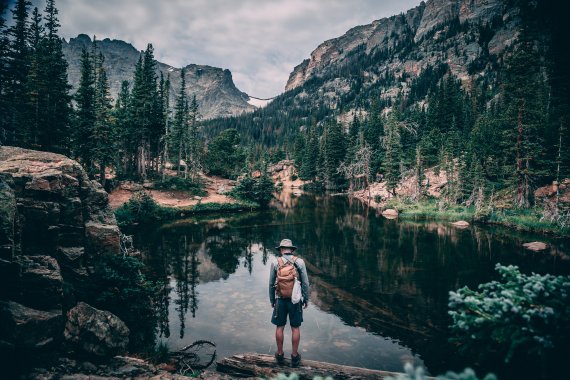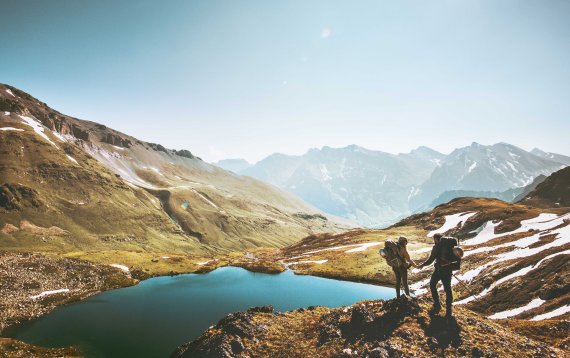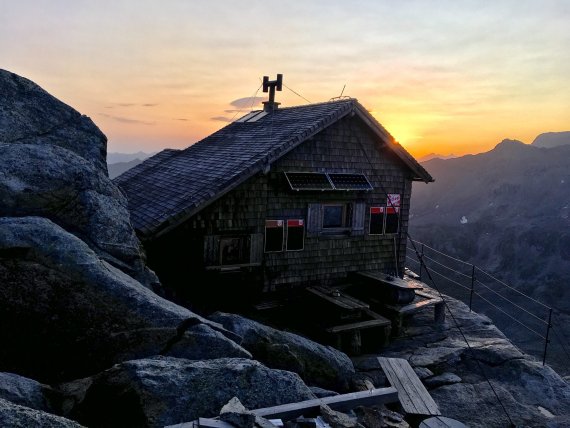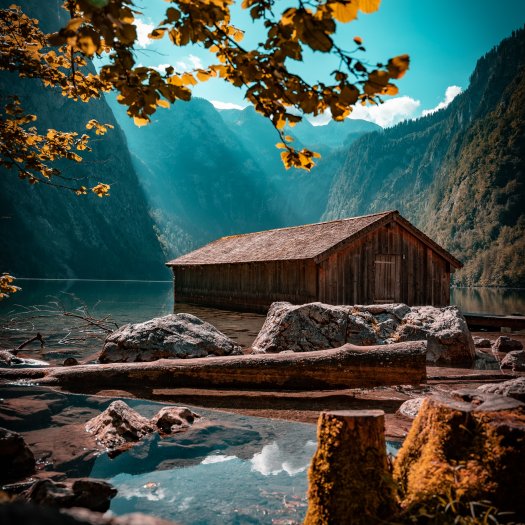Hut trekking in the Alps has a long tradition. More than 150 years ago, the first huts were built for outdoor fans, offering protection and later more and more comfort. Meanwhile, there are well over 1,000 such huts in Europe - some of the most beautiful are located on the trekking tours selected here. ISPO.com presents the 15 most beautiful hut tours in Europe. Whether it's a day tour or a hike lasting several days - there's something here for all hikers and outdoor friends.
- Hut tour - On foot across the Alps
- Trekking to the Gamskarkogel Hut
- Mountain hut tour - Trekking in the Wilder Kaiser
- Trekking in the Sulz Valley in the Stubai Alps
- Glacier tour in summer at Wildhorn
- Mountain sports at the foot of the Matterhorn
- Hiking on the Greina Plateau
- Climbing the highest peak in Slovenia
- Mountain sports in the picturesque Seven Lakes Valley
- Hiking on the Slovenian Alpine Trail
Among the various hut tours, one in particular stands out: the famous Alpine crossing from Oberstdorf to Merano. On average, you will cover between ten and 20 kilometres a day and tackle 800 to 1,200 metres in altitude. But once you have completed the tour, you will never forget the experience!
The tour is best tackled between mid-July and mid-September, as most of the old snow has melted by this time. At the same time, you should inform yourself in advance about alternative routes or descent options in case the weather makes a change of plans necessary.
TheGamskarkogelhütte in the Großartal is considered one of the oldest "tourist" refuges in Austria and the entire Alpine region. Archduke Johann of Austria did something for the development of the region when he built it in 1828 - by no means selflessly, as he used the hut and the increasingly well-developed trail himself with his hunting parties.
Today, several paths lead to the Gamskarkogelhütte at an altitude of just under 2,500 metres, which, assuming good physical condition, fitness and health, can also be mastered by non-Alpinists. The panoramic ascent via Rastözenalm, Schmalzscharte, Frauen- and Gamskarkogel takes a good five hours. A good starting point for trekking or hiking is near the Annen Café in Bad Hofgastein at an altitude of about 1,000 metres. From here you can reach the Rastözenalm via forest paths, where there are several possibilities for refreshments. The rest of the trail is well signposted.

A good 30 kilometres of trail and 2,500 metres of altitude - for trekking fans, that sounds like a fulfilling weekend. You will find what you are looking for on a beautiful tour in the south of the Kaisergebirge with a start in Going. From around 800 metres, the route first climbs to theObere Regalm and then - after a hearty snack - via the Wilder-Kaiser-Steig 827 to the Baumgartnerköfl. This is followed by the Gaudeamushütte, where you can also spend the night. From here, the route continues partly via iron ladders through the Klamml towards theGruttenhütte at 1,620 metres. This is literally the highlight of the tour. If you don't want to take the same way back, you can descend to the Wochenbrunner Alm by the shortest route. Ellmau is now not far away.
It is 2,135 metres high, the cosyAmbergerhütte, which can be reached in less than two hours when hiking from Gries. The trail initially leads through the fields without any major inclines, then into the forest and steeply up to the Sulztalalm and Obere Sulztalalm. Several times you have to cross the parallel Fischbach stream over bridges. The path is well developed and, despite the 600 metres in altitude, can also be mastered by children. It is worth it for the younger ones, because the hut is well prepared for children and offers numerous opportunities to play in nature - from seesaws and swings to a refreshing swim in the nearby pond.
Botanists also get their money's worth here, because especially in summer the alpine meadows are covered all over with flowers. Those who stay in the cosy rooms for a few days will find numerous opportunities for hiking or mountaineering, for example in about two hours on the Sulzkogel (approx. 2,800 metres) or in just under five hours on the Schrankogel (approx. 3,500 metres).
If you only know the Bernese Oberland from skiing holidays, you should consider a weekend of hut trekking there in the warmer months. The well-known winter sports resort of Lenk in the Simmental is the starting point for a two-day hut trekking to the glacier tongues on the Wildhorn. From the end of June to the beginning of October, the Swiss Alpine Club'sWildhorn Hut in the Gelten-Iffigen nature reserve welcomes 96 overnight guests in its nine rooms. The easiest way to get to the mountain hut at the foot of the Wildhorn (3248 m), which is 2,303 metres above sea level, from Lenk is from Iffigenalp. The alp, 1,600 metres above sea level, can be reached by post bus. From there, the route leads on foot through the picturesque Iffigen valley past the Iffigensee lake. The walking time to the mountain hut is given as 2:45 hours. The difference in altitude is about 700 metres. The 3-course menu with regional dishes in the Wildhornhütte compensates for the effort of the ascent during the trekking.
The next day starts with the glacier tongue tour. From the Tungel Glacier, the route leads over the Chilchli Glacier to the Ténéhet Glacier with its unique alpine flora. Via the Rawilpass and the impressive Saumweg trail you return to Iffigenalp and from there by post bus back to the starting point in Lenk in Simmertal.
The area around Zermatt with the famous Matterhorn has two long-distance hiking trails in store with the Bear Trek and the Matterhorn Trek, which lead through the most beautiful mountain regions of the Swiss Alps in tours lasting several days: past the mighty four-thousand-metre peaks and the famous three-thousand-metre peaks of the Eiger, Mönch and Jungfrau.
Those who are also keen on high alpine trekking because of the risk of altitude sickness can go hiking in the Valais against the breathtaking backdrop of the highest peaks on the Tour de Muverans at an average altitude of two thousand metres. The 61km route takes a minimum of three days for athletic hikers and can be easily extended thanks to the dense network of mountain huts. For a four-day tour, daily walking times of between four and six hours can be expected. Start and finish is in Ovorannaz. Overnight stays are in the following huts: Cabane du Chalet Neuf, Auberge du Pont-de-Nant and on the third night in Derborence. Maps for the various routes of the Muverans Tour are available at the localtourist centre in Ovorannaz.

One of the most beautiful hut tours for multi-day trekking in Switzerland is the unspoilt nature of the Greina between Ticino and Graubünden. The Greina plateau lies at an altitude of 2,200 metres and can be accessed from both cantons. It offers a total of four huts for overnight stays. A particularly recommended tour begins in Campo Blenio (1,216m) with the ascent to Pian Geirètt at 1,975 metres. In summer, you can save yourself this stretch of about 3.5 hours by taking the bus to Pan Geirètt. From there it takes about 45 minutes to reach the Scaletta hut. After the overnight stay or in connection with the summer bus only stop and refreshment you continue the same or next day over the Greinapass (2.357m). On the other side of the Greina plain, one of the trails leads to the popularTerri Hut. The stretch there over the pass takes about three hours.
The next morning follows a more or less extended trekking through the beautiful tundra landscape with its branched small river and a 15m wide natural stone arch (Arco della Greina). Sooner or later you will return via the Greina Pass and from Pian Geirètt back to Campo Blenio by bus or on foot.
Those who travel by public transport in Slovenia can start the trekking tour to Triglav in the capital Lubljana. From the main train station there is a train to Jesenice and there at the station a bus to Mojstrana to Triglav National Park. In the village, which is 660 metres above sea level, a 12-kilometre trail leads through the Vrata Valley along the impressive Pericnik Waterfall to Aljažev Dom, a hut at an altitude of 1,015 metres.
The hut is already located in the middle of the national park and has a spacious room to spend the night and a large parking lot. Drivers can also set off directly from there for the trekking tour. Don't miss the gigantic view of the 1,800-metre-high north face of Triglav from the hut's usually well-visited terrace! The play of colors at sunset alone is worth the overnight stay.
The trekking stage from the Aljažev House to the next hut, the Triglavski dom (Triglav House), which is already 350 metres below the summit, is estimated to take six hours. There are three trails to choose from, ranging from easy to difficult, all starting at the Triglav monument. The moderately difficult tour leads upwards via the Tominšek via ferrata, partly on vertical rock slabs. This tour is only recommended for climbers with a head for heights and a via ferrata set and helmet. Arrived at the Triglav House, the effort of the ascent to 2,515 meters is rewarded in clear weather with a magnificent view over the Julian Alps to Austria and Italy.
After spending the night in the Triglav House, the first thing to do is to climb to the summit. The easy via ferrata only requires a helmet from experienced mountaineers. With hopefully good visibility conditions, the breathtaking view of the Großglockner, the Dolomites and the Adriatic Sea now awaits.
From the summit of Triglav, the descent via the south side initially leads 700 metres down through moon-like landscape to the Tržaška-Koca mountain hut. From there, the route continues along a small pass into the picturesque Seven Lakes Valley with its magnificent glacial lakes. The destination is the beautifully situated Seven Lakes Hut (Koca pri Triglavskih jezerih) at an altitude of 1,685 metres. An alternative in an easterly direction is the managed Planina Visevnik hut, which is reached via the Planina Ovcarija alpine pasture. From there you can already see the emerald green Bohinj Lake, the destination of the trekking tour. The descent to Ribcev Laz is via the village of Stara Fužina. From the only campsite on the western shore of the glacial lake, a bus takes you to Bohinjska Bistrica for the train to Bled and Jesenice, and from there a bus back to Mojstrana. If you only have time for a two- to three-day trek to Triglav, you can start and finish the 38 km route in Stara Fužina.
One of the most popular trekking tours leads along the country's first and oldest hiking trail, the Slovenian Alpine Trail (Slovenska planinska pot). Starting from Maribor, it connects all the major peaks of the country over a distance of 500 kilometres, from the Pohorje Mountains to the Stein Alps, the Karavanke Mountains, the Julian Alps and the Karst Mountains, ending in Ankaran on the Adriatic Sea. The wide mountain ridge Pohorje (Bacher Mountains) with its many moors, bog lakes and extensive forests can be crossed from west to east in three or four days. From the worth seeing city of Maribor, a bus takes you to the starting point of the 50 kilometre trekking tour to Ruse on the Drava (Drava) river. There the ascent to the Sumik moor forest with its impressive waterfalls begins. Passing the Black Lake Crno jezero, the first stage leads via Trije Kralji to Dom na Osankarisi with an overnight stay or straight on to the hut Dom na Pesku. From there it goes to the Rogla (1.517 m). In good weather there is a magnificent view over the countryside. Along the famous Lorenc moor lakes, the hike continues on the plateau to the mountain hut Ribniska koca. The next morning we descend to Ribnica. There, buses will take you back to Maribor.

You should plan around 15 hours of pure running time for this tour, which places high demands on fitness and surefootedness. Thanks to the Watzmannhaus and the Wimbachgrieshütte, these 15 hours can be perfectly divided into three days. Start at the Wimbach bridge, following the signs to theWatzmannhaus. On the ascent you pass the Stubenalm, which invites you to stop for a break at an altitude of around 1,100 metres. The Watzmannhaus is reached at 1,930 metres.
The ascent on the following day leads to the rugged ridge and along it directly in places. The route is partly secured with wire ropes. After the highest point, the Watzmann-Südspitze (2,712 metres), the route descends steeply in parts into the valley and, after a wide scree band, on firm paths to theWimbachgrieshütte. From here you can either walk back to the starting point of the tour, or in about five hours via the Hirschwiesenkopf to the Königssee. A more beautiful view of the lake is hard to come by and the water also makes for a rewarding destination after the hard trekking.
The German-Austrian border runs over the 2,592 metre high Hochvogel. The imposing peak is considered a landmark of the Allgäu Alps - on this tour you always have it well in view. With a trekking time of three hours and a total of around 900 metres in altitude, the hut tour is also recommended for trekking beginners, despite the steep forest passages. The start is at 1,100 metres altitude in Hinterhornbach. From here, it goes over forest roads beyond the tree line to the Kaufbeurer Haus, which is located at an altitude of 2,000 meters and currently (as of May 2016) offers 14 sleeping places. However, the hut is only open on weekends from Whitsun to October.
Several trekking tours start at theKaufbeurer Haus. For passionate hikers, the path to the Bretterspitze, which is about 2,600 meters high, is well manageable. Those who want to tackle the Urbeleskarspitze should have solid mountaineering skills.
Kärlingerhaus, Riemannhaus, Ingolstädter Haus - the three traditional huts are among the most popular trekking destinations in the Berchtesgaden Alps. They can be experienced together on a high-altitude tour lasting several days, whereby you are guaranteed to meet like-minded people, especially in summer. The starting point is in St. Bartholomä am Königssee. After a few steps along the shore, the trail climbs steeply uphill as it reaches the Schrainbach stream. The Kärlingerhaus is reached in 3.5 hours. If you want, you can stay for several days in the wonderful surroundings of the hut at Funtensee at an altitude of a good 1,600 metres and explore the mountain world of the region in a star shape. It takes about 2.5 hours to reach the Riemannhaus and another 2.5 hours to reach theIngolstädter Haus. The hut at the foot of the Großer Hundstodes at around 2,100 metres altitude is considered one of the most beautiful refuges in the Alpine region.
Grenoble on the left, Turin on the right, and somewhere in the vast land in between, right on the French-Italian border, lies the Vallée de la Clarée. It's a good place to stay: The people are friendly (knowledge of French, however, is a great advantage) and those who love hiking will not want to leave at all. Various trekking tours lead into the surrounding mountains, for example to theRefuge Buffère, where cheese, wine and an in-house liqueur are served in addition to the daily dishes and the traditional "tarte myrtille du refuge". If you want to stay overnight, however, you should make a reservation. The popular house is located directly on theVia Alpina, which stretches 5,000 kilometres through the Alpine region, including Germany, Austria and Switzerland. Trekking the entire distance would take you pretty much a year.

A giant like the Via Alpina also awaits you on Corsica with the "G20". You can follow the long-distance hiking trail across the island for around 180 kilometres, taking you from the sea to one of the most pristine mountain regions on the continent. Here you stand in the snow at 2,400 metres, while only a few kilometres away you seek shelter from the heat after a swim.
This trekking tour should not be taken lightly, as it has an alpine character. Absolute sure-footedness is required, as well as the practiced use of chains, ropes and ladders. A good level of fitness is also an advantage, as more than 12,000 metres of altitude are covered.
The start of the G20 in the north is Calenzana, a village in the Batasca Valley, the end point is the village of Conca in the south, from where the lively Porto Vecchio is then easily reached. Between these two points there are around 15 daily stages, with always a refugio to rest your weary head in the evening.
 OutDoor by ISPOOutDoor in transition
OutDoor by ISPOOutDoor in transition
- ISPO awards
- Mountain sports
- Bike
- Design
- Retail
- Fitness
- Health
- ISPO Job Market
- ISPO Munich
- ISPO Shanghai
- Running
- Brands
- Sustainability
- Olympia
- OutDoor
- Promotion
- Sports Business
- ISPO Textrends
- Triathlon
- Water sports
- Winter sports
- eSports
- SportsTech
- OutDoor by ISPO
- Heroes
- Transformation
- Sport Fashion
- Urban Culture
- Challenges of a CEO
- Trade fairs
- Sports
- Find the Balance
- Product reviews
- Newsletter Exclusive Area
- Magazine






